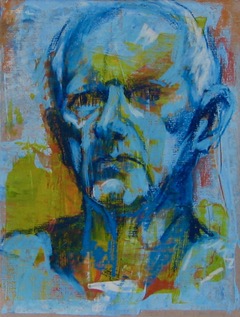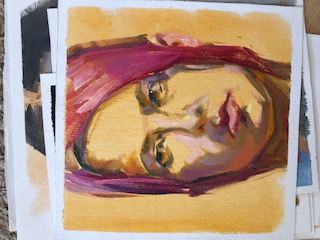Cottonwood Center for the Arts: Art Is Important!
- Marjorie Vernelle

- Jun 15, 2021
- 6 min read
Updated: Jun 18, 2021

When is an alley not an alley? A romantic would say, "when it is a laneway," but that is just semantics. Alleys are normally the backsides of streets, non-descript at best, scary at worst, and a necessary evil in between. However, alleys and small, otherwise forgettable side streets have a great friend - ART! That becomes quite clear when looking at Cottonwood Center for the Arts' redevelopment plans for its front entrance, which faces small, one-block-long Corona Street, and for the alley that runs along one side of the building. Cottonwood garnered enthusiastic public support from art lovers of all stripes by issuing a special edition sale of bricks to be used to pave the area in front of the Corona Street entrance. These are not just any old bricks. These bricks have the purchaser's favorite inspirational saying printed on them. The goal is to transform an otherwise ordinary entrance into a place of charm and inspiration, with a distinct look that flatters the entrance as it lifts the spirits of all who come there. Then comes the alley project (see video below). It is just another way that Cottonwood acts as a type of cultural bouillon cube that seasons and flavors the many aspects of art it encompasses.

Cottonwood thrives within that cultural bouillon by allowing expression. When artists arrive in Colorado Springs, the first place to go is Cottonwood Center for the Arts. Once in the environment of creativity found there, the artists know they have landed in the right place. Cottonwood creates that energy because art has transformational power. However, it needs stewardship. Cottonwood has been around Colorado Springs for many years in different locations. It always has offered art classes, Life Drawing open studios, and exhibition opportunities. Yet, for a long while it was a rather friendly club for art lovers, small and chummy. In 2009 the organization was able to take advantage of the downturn in property values to purchase the large building at its current location, 427 E. Pikes Peak. It struggled along for a while, until it found itself soon coming to a dead end. What to do? In 2012 the answer was found when the chairman of the board of Cottonwood installed a new director, Jon Khoury. Khoury, a graduate of Colorado College, was called back to Colorado from his life in New York, where he was a music promoter. With Khoury came a restructuring of CCA based on three guiding principles. 1) Art is critically important. 2) Art is In-clusive not Ex-clusive. 3) Art organizations, though non-profit, should and must be financially self-sustaining.

Starting with the last of those, though it is not the least, Cottonwood became innovative. Being a self-sustaining non-profit can involve many things, and one of those for Cottonwood is the Curation and Staging program. One of the artists, Jess Preble, recently said in a video that she wished that earlier in her career, she had had the ability to have her art curated and presented to the community. That was not possible when she lived in bigger cities like San Francisco with art establishments that often turn away artists who are early in their careers. However, CCA started working with the local business community to provide the art of local artists to enliven the offices and facilities of those businesses. The Curation and Staging program also does home curation, which allows clients to try out a piece of art in an area of their home. This is done through a leasing program that is financially beneficial to businesses and individual clients, to CCA, and to the artists whose work is displayed.

Art requires that artists have a place to create, to exhibit, and to sell art. Among the things that make CCA self-sustaining is the array of different types of studio spaces for artists to rent, for reasonable rates, as places where they can produce their art. The studios allow the public to engage in all kinds of art production and art businesses, as well as purchase handcrafted items and original artworks. The galleries at CCA run a program of art exhibitions throughout the year, which engage the public and sell the artists' work just as any gallery would. All of these have a place in the financial sustainability of the art center, which operates with a paid staff rather than volunteers. It is not that volunteerism is discouraged, but Cottonwood's firm belief is that working in the arts is work like any other work and should be paid. The operation of the center needs to be done on a professional level, hence a compensated staff. At Cottonwood art and business intersect, and that happens on all levels.
Forgotten Places Watercolor Columbine Draw Anyway!
These works come from the one-day workshops named above, lead by artists, Deb Prewit, Laura Raborn, and Kris Gideon.
Art transforms people and places, because it is a process of discovery. So many people look at art, feel inspired, but then think that there is no way they can express what they feel. Oh ney, ney! Art is a communication. The ways to express are many, and none of them are secret. Cottonwood Center for the Arts is very much dedicated to art education and runs a variety of classes, from one-day workshops to four-week courses, using both in-person and distance learning formats. From painting in acrylic, oil, and watercolor, to drawing, digital art, and even stained glass, Cottonwood covers all areas with classes for both adults and children. Should the artistry of the well-placed word be someone's most cherished form of expression, there are in-person and online courses in poetry and creative writing.
The premise that art helps people find their place in the world and that all art speaks to whomever views it, whether that person likes the piece or not, is basic to this arts center. The guiding principle once again is inclusivity as opposed to exclusivity. Everything in the building speaks to everyone. Personal preferences may cause a visitor to dislike one piece but adore and purchase another, and that is quite normal. The main thing is that the rules of what can be accepted are not so narrow and highly codified that much is left out, with the remainder only for an elite group who "would understand it." All humans have understood art since the dawn of time. Just think of the prehistoric cave paintings in Lascaux. Done when any human was likely to be stepped on by a woolly mammoth, those paintings show that humans entered those caves and made fabulous representations of the creatures in the world that surrounded them.
Art is important, has always been important, and will always be important to human existence. Different human cultures produce different kinds of art because they have different world views. There is no limit to what is called art. A key issue in the development of appreciation within the community for art that extends beyond just one genre or just this region is the concept of diversity. This again refers to the human commonality of art creation. CCA does not seek to be a regional arts center. To that end, there are programs that involve mixtures of art and music, art and poetry, theater arts, dance, and the presentation of forms of contemporary art, and abstract art, as well as the regional favorite of spectacular landscape painting. Included in this expansive view is celebration of special events in one community that can be shared by all, like the Juneteenth Celebration of African-American art.
Of course, it is critically important to have a place where artists can gather and share information and experiences. In the early 1900s, there was in Paris in Montmartre a place known as La Ruche, or the Beehive. It was actually a residence where artists worked and lived. It still is the location of about 50 artists who put on performances and art exhibitions. While CCA is not a residence, it is a hive of different types of artistic activity, as evidenced by all the types of things created in the artists' studios. However, other types of communication are possible because artists have proximity to one another within a creative environment, that cultural bouillon mentioned earlier. At Cottonwood, artists can participate in discussions on how to write an artist's biography or ways of pricing their paintings, in the monthly meetings of the Artist Café, which include open critique sessions as well. Artists can also find an essential to artistic development, Life Drawing, in open Life Drawing studios twice a week that invite any artist who wants to work with the human figure by viewing a live model.
Joe by Sue Johnson Hannah by Rita Scafidi Erin by M. Vernelle
These portraits were done during the Life Drawing sessions.
Leonardo da Vinci kept the Mona Lisa until the day of his death in France in 1519. Legend has it that he did not think it was finished. In some sense it was always very much alive in the mind of the artist. An arts center like Cottonwood Center for the Arts is very much a living piece of art itself. That can be seen in this video about the redevelopment (resurrection?) of the alley beside the center, https://youtu.be/NxzhLD--5NY. While life is short, art is long, and so it goes.

So we end where we began with the bricks and the alley. The Bricks-r-us campaign ends at the end of June, so now is the time to participate. Just call Cottonwood (719) 520-1899 or go to www.bricksrus.com
For more on Cottonwood Center for the Arts, click the link given here: https://cottonwoodcenterforthearts.com
For a video on CCA, see this video on youtube: https://www.youtube.com/watch?v=8pE4G-0V66E
For more on Marjorie Vernelle, see the author page at amazon.com/author/marjorievernelle
She also has an engaging art history blog that talks of painting and wine on ofartandwine.com
© Marjorie Vernelle 2021













Comments